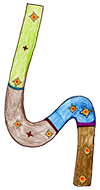Ticuna Sky
 The Museum of Astronomy and Related Sciences (MAST) is showing for the first time the itinerant exhibition "Ticuna Sky," with the themes of knowledge of the sky, seasonality, and sustainability in iconographic representations on ritual indigenous artifacts. The exhibition will be held between 13 - 23 October in the hall of the Annex Building of MAST, from Tuesday – Friday, 9am -5pm.
The Museum of Astronomy and Related Sciences (MAST) is showing for the first time the itinerant exhibition "Ticuna Sky," with the themes of knowledge of the sky, seasonality, and sustainability in iconographic representations on ritual indigenous artifacts. The exhibition will be held between 13 - 23 October in the hall of the Annex Building of MAST, from Tuesday – Friday, 9am -5pm."Ticuna Sky" is about the Ticuna Indians from Amazonas and reveals their knowledge about the sky and the seasonality of rain and drought, which guides subsistence strategies in relation to agricultural and fishing activities, involving economic sustainability. For this, the exhibition visually links the movement of celestial bodies in the journeys of the German ethnologist Curt Nimuendajú in 1941 and 1942 to the Ticuna area with the iconography of the artifacts collected in the same journeys.
"Although the indigenous interpretation does not coincide exactly with the valid scientific theories nowadays about the movement of the planets and the stars in the sky, the sky identification techniques allow a correlation of the vision of the indigenous world and the classifications universally accepted in Astronomy," explains the curator of the exhibition and researcher from the Coordination of History of Science in MAST, Priscila Faulhaber. Curt lived with a large number of indigenous ethnicities, from various regions in Brazil, for more than 40 years, including the Ticuna ethnicity from Amazonas.
The exhibition has 12 photographic panels with photos of artifacts collected by Curt Nimuendajú for the Goeldi Museum in 1941 and 1942; photos of Ticuna Indians from 1997 - 2010 captured in fieldwork by Priscila Faulhaber, as well as photos of areas of the sky related to the celestial bodies and the constellations referred to in the iconography of the artifacts. "Ticuna Sky" will also show a DVD consisting of three videos about the Ticuna female puberty ritual and the environment, and a celestial wheel made by a Ticuna artisan.
"Ticuna Sky" will look at the concept of the green economy in which it is supposed that the practices and knowledge of a wide range of social actors have to be considered in programs of sustainable development. It has the aim of being a contribution of the history of science to the contemplation of aspects of the Ticuna Indians' knowledge about the sky and seasonality. This approach can contribute to scientific and technology and innovation strategies, also allowing the inclusion of the knowledge of these Indians in the information community.
The exhibition will also make available the fifth edition of the Magüta Arü Inü CD-ROM, which works with the idea of a Ticuna memory game in the contemplation of the iconography of the ritual artifacts. The iconography is a form of visual language which uses images to interpret a determined theme. The CD-ROM contemplates the iconography of the artifacts and translates, for example, visualization of dream stories told by grandmothers to the girls initiated in their female puberty ritual. Magüta Arü Inü was prepared in 2002 together with the Ticuna Indians sixty years after the collection of artifacts by Curt Nimuendajú. In 2015, CD-Rom is being issued for the fifth time and coincides with the 70th anniversary of the death of Curt, which will occur on 10 December 2015. MAST is located at Rua General Bruce 586, Bairro Imperial de São Cristóvão, RJ. Entrance is free.





